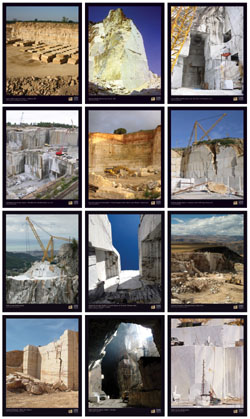In the beginning, there was Thin Porcelain Panels. Between 2000 and 2001, Thin Porcelain Tile (TPT) was born. One version was created in 2001 by engineer, Franco Stefani, of the Systems Group, innovator of the ceramic industry. This product was conceived by creating the production technique using a large plate pressing process for large, thin porcelain panels called Laminam.
Another version of TPT using a roller press process, which continuously moves the entire manufacturing, print, design and cutting process, was created by the Sacmi Imola Group, which was called Continua, now the Continua+ manufacturing equipment/process.
The design communities fell in love with TPT, something completely new and very beautiful.
So, installations began anywhere and everywhere.
Then, unfortunately, there were failures anywhere and everywhere, primarily due to lack of properly trained contractors, as well as improper tooling available.
As a collective effort to reduce installation failures due to lack of product knowledge and proper installation methods, the panel manufacturers and setting material companies began providing installation training.
These panel manufacturers and setting material manufacturers like Custom Building Products, along with The Tile Council of North America (TCNA), began conducting material testing and installation methods development from 2011 forward. Hundreds of thousands of dollars were invested in laboratory and installation method testing over five to six years in support of the TPT product segment.
In September 2014, the industry was still in discussions about what to name the product, as there were no standards for the manufacturing or installation of the tile. Standards for this product category were still being developed by TCNA, American National Standards Institute (ANSI) and International Organization for Standardization (ISO), which were in a technical sub-committee with testing and document development.
These panel manufacturers and setting material manufacturers like Custom Building Products, along with The Tile Council of North America (TCNA), began conducting material testing and installation methods development from 2011 forward. Hundreds of thousands of dollars were invested in laboratory and installation method testing over five to six years in support of the TPT product segment.
In September 2014, the industry was still in discussions about what to name the product, as there were no standards for the manufacturing or installation of the tile. Standards for this product category were still being developed by TCNA, American National Standards Institute (ANSI) and International Organization for Standardization (ISO), which were in a technical sub-committee with testing and document development.
With no standards available, the tile markets decided to move forward with recommendations based on the designs and materials available. In general, the consensus was that a 6-mm-thick panel was good for exterior facades, interior wall cladding and flooring applications. At the same time, it was determined that the 3-mm-thick panels were ideal for millwork and tile-over-tile applications, and finally, that 12-mm-thick panels were excellent for countertop applications and slab vein-matching accents.
TPT to GPT and GPTP
TPT did not clearly identify size or thickness of the various range of products available nor would one terminology allow performance standards to be developed for various products. Panel manufactures and ANSI Technical Committee members discussed options and decided to utilize terminology from the wire industry, specifically the American Wire Gauge (AWG), which covers all thicknesses of product offerings and enables differentiation of product performance standards. The AWG is currently standardized by ASTM/American Society of Testing Materials B 258-18/Standard Specification for Standard Nominal Diameters and Cross-Sectional Areas of AWG Sizes of Solid Round Wires Used as Electrical Conductors.
In November 2017, a historical event in the tile industry took place. For the first time, material and installation standards were developed, voted on and passed simultaneously through the ANSI Technical Committees.
The material standard was ANSI A137.3/American National Standards Specifications for Gauged Porcelain Tile and Gauged Porcelain Tile Panels/Slabs (GPTP), and the installation standard was A108.19 Interior Installation of Gauged Porcelain Tiles and Gauged Porcelain Tile Panels/Slabs by Thin-Bed Method bonded with Modified Dry-Set Cement Mortar or Improved Modified Dry-Set Cement Mortar.
Then came new manufacturing facilities, which were completed in the U.S. in September 2018. Iris Ceramica Group, parent company of StonePeak, SapienStone, FMG, Porcelaingres, Ariostea, Eiffelgres and Fiandre, invested $70 million dollars in an expansion that added 160 workers to the facility, which now measures 1 million square feet.
Shortly after came the question: what about the size for exterior installations? The International Building Code (IBC) limits size and weight of exterior adhered veneers such as porcelain tile, stone, etc. Currently, the International Code Council’s (ICC) IBC: [BS] 202, Table 1404.2, [BS] 1404.10.2 for exterior adhered materials and [BS]1405.10.2 Exterior adhered masonry veneers - porcelain tile states that adhered units shall not exceed ⅝-inch (15.8-mm) thickness and 24 inches (610 mm) in any face dimension no more than 3 square feet (0.28 m2) in total face area and shall not weigh more than 9 pounds psf (0.43 kN/m2). Porcelain tile shall be adhered to an approved backing system.
This clearly excludes most GPTP when used in common sizes, even though GPTP weighs as low as 3 pounds psf.
This led to confusion for projects where the IBC standard was listed in architectural specifications and in some cases held up panel installations. The general process is to apply for a variance from the specified standard and because GPTP is lightweight, most projects were approved and installation proceeded. Nonetheless, specifiers and contractors all needed more information and they needed it yesterday, which led us to the latest “anticipated” developments.
On May 6, 2019, compliments to the efforts of the TCNA and the International Masonry Institute (IMI), the IBC initially approved revisions/updates to code/Chapter 14 as below, scheduled to be published in 2021.
Future efforts and discussion after successful install history can be established on larger modules.
So what’s next?
The New, Forthcoming Exterior Installation Standard
The new exterior installation standard, which is anticipated to come to the market soon, is A108.20 Exterior Installation of Gauged Porcelain Tiles and Gauged Porcelain Tile Panels/Slabs by Thin-Bed Method bonded with Modified Dry-Set Cement Mortar or Improved Modified Dry-Set Cement Mortar. What was initially perceived as a niche type product in the tile industry has become very popular, with millions of square feet manufactured, sold and successfully installed.
Since then, hundreds of GPTP installation training sessions took place over several years, which were administered by the National Tile Contractors Association (NTCA), as well as panel manufacturers and setting materials manufacturers like Custom.
Training is crucial to a successful installation for those contractors who have never installed GPTP. It’s so crucial that the ANSI A108.19 Technical Committee included language specific to what a “Qualified Installer Program” is, which can be found in section 10 as a requirement to complete before installation is to proceed. So, what that means is if your project has GPTP and has ANSI A108.19 listed in the architectural specification, you need to have this training.
Additionally, because installation knowledge is so crucial to a successful installation, more language has been submitted to be included in the next publishing that clearly outlines what an Installer Qualification Program will be required to consist of in way of training content and hands-on training elements.



















